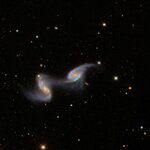Space
The Big Dipper has a secret, invisible to the unaided eye, according to a new paper published in The Astrophysical Journal, which says that one of the stars that makes the bend in the ladle's handle, Alcor, has a smaller red dwarf companion.
Newly discovered Alcor B orbits its larger sibling and was caught in the act with an innovative technique called "common parallactic motion" by members of Project 1640, an international collaborative team that includes astrophysicists at the American Museum of Natural History, the University of Cambridge's Institute of Astronomy, the California Institute…

Virgin Galactic officially debuts SpaceShipTwo, named the VSS Enterprise, fast on the heels of their earlier ready for liftoff announcement in Wired. From the Wired article, they noted
In a year, maybe two — barring any test-flight glitches — people who have the right financial stuff will be rocketing daily into space for a few minutes of sensory overload and ego gratification. It may not be the colonization of Mars, but as Siebold says, “did the Wright brothers have Boeing 747s in their consciousness when they flew at Kitty Hawk? No, but it just grows from here; what they achieved made…

A new study appearing tomorrow in Earth and Planetary Science Letters rules out the possibility that the methane on Mars was delivered by meteorites, boosting the theory that life exists on the red planet.
Researchers had thought that meteorites might be responsible for Martian methane levels because when the rocks enter the planet's atmosphere they are subjected to intense heat, causing a chemical reaction that releases methane and other gases into the atmosphere.
However, the new study, by researchers from Imperial College London, shows that the volumes of methane that could be released by…
Astronomers at the Max Planck Institute for Astronomy have discovered and directly imaged a faint celestial body that orbits the star GJ 758. Its mass is estimated to be between 10 and 40 Jupiter masses.
Accordingly, it is either a giant planet or a brown dwarf, a would-be sun. One thing is certain: with a temperature of around 330 degrees Celsius, GJ 758 B is the coldest companion of a Sun-like star ever to be directly imaged. The discovery is detailed in Astrophysical Journal Letters
GJ 758 B was detected during two independent observation runs in May and August 2009. The images show…

Two things I like are open research and seeing my tax dollars get used effectively. The National Science Foundation (NSF) just did both in one swoop. As reported in detail on NASW, over two decades of earlier NSF work is now available online. The magazine Mosaic just released "An on-line archive of articles published in The National Science Foundation’s flagship magazine from 1970 to 1992."
There's over 593 articles full of useful science there, in case you get bored reading ScientificBlogging.
Alex, the Daytime Astronomer
Tues and Fri here, via RSS feed, and twitter @…
If Darth Vader friend-requested you and you clicked "Ignore," do you think he would know? I don't think I'd take that chance...
Tip of the lightsaber to the GEH and to Brian Murphy at College Humor.

'Many eyes' is a better approach to image recognition than algorithms. When looking at real-universe galaxy merger remnants, and comparing them with simulations, it's better to just have lots of people look at hundreds of possible results (and match them to reality), than to use a machine method. Earlier this week I forwarded details on the Galaxy Zoo 2: Mergers project, which allows you (yes, you! What are you waiting for? Match some galaxies!) do this.
Now, modeling collisional remnants was the topic of my Ph.D. work. I was looking at Graham's Ring, aka AM0644-741,…
The first large black holes in the universe likely grew deep inside gigantic, starlike cocoons that smothered their powerful x-ray radiation and prevented surrounding gases from being blown away, says a new study published in Monthly Notices of the Royal Astronomical Society.
The formation process involved two stages, said Mitchell Begelman, a professor and the chair of CU-Boulder's astrophysical and planetary sciences department. The predecessors to black hole formation, objects called supermassive stars, probably started forming within the first few hundred million years after the Big Bang…

EMBARGOED until: 24 November 2009 00:01 GMT
‘COSMIC SLOT MACHINE’ MATCHES GALAXY COLLISIONS
A new website will give everyone the chance to contribute to science by playing a ‘cosmic slot machine’ and compare images of colliding galaxies with millions of simulated images of galactic pile-ups.
These collisions, which astronomers call ‘galactic mergers’, could be the key to finding out why the Universe contains the mix of galaxies it does -- some with trailing spiral arms, others more like compact ‘balls’ of stars.
Surprisingly, humans are much better than computers at spotting the best match…

I'm a reasonable man, but there's a laxness in cyberspace I just can't abide with. And I'm talking to you, space.com. I'll say it straight, you may know science but you ain't giving your readers any links to the real stuff. You just echo-chamber yourself-- all your dang blag links link back to you! If you ain't gonna share your references, you ain't doing science, just flappin' yer gums. Buck up and cite like a man, ya here?
Let's look at us down home at ScientificBlogging. We got us an article on NASA's report of 'water on the Moon'. It's a purty piece, maybe a bit talky, but it's got itself…